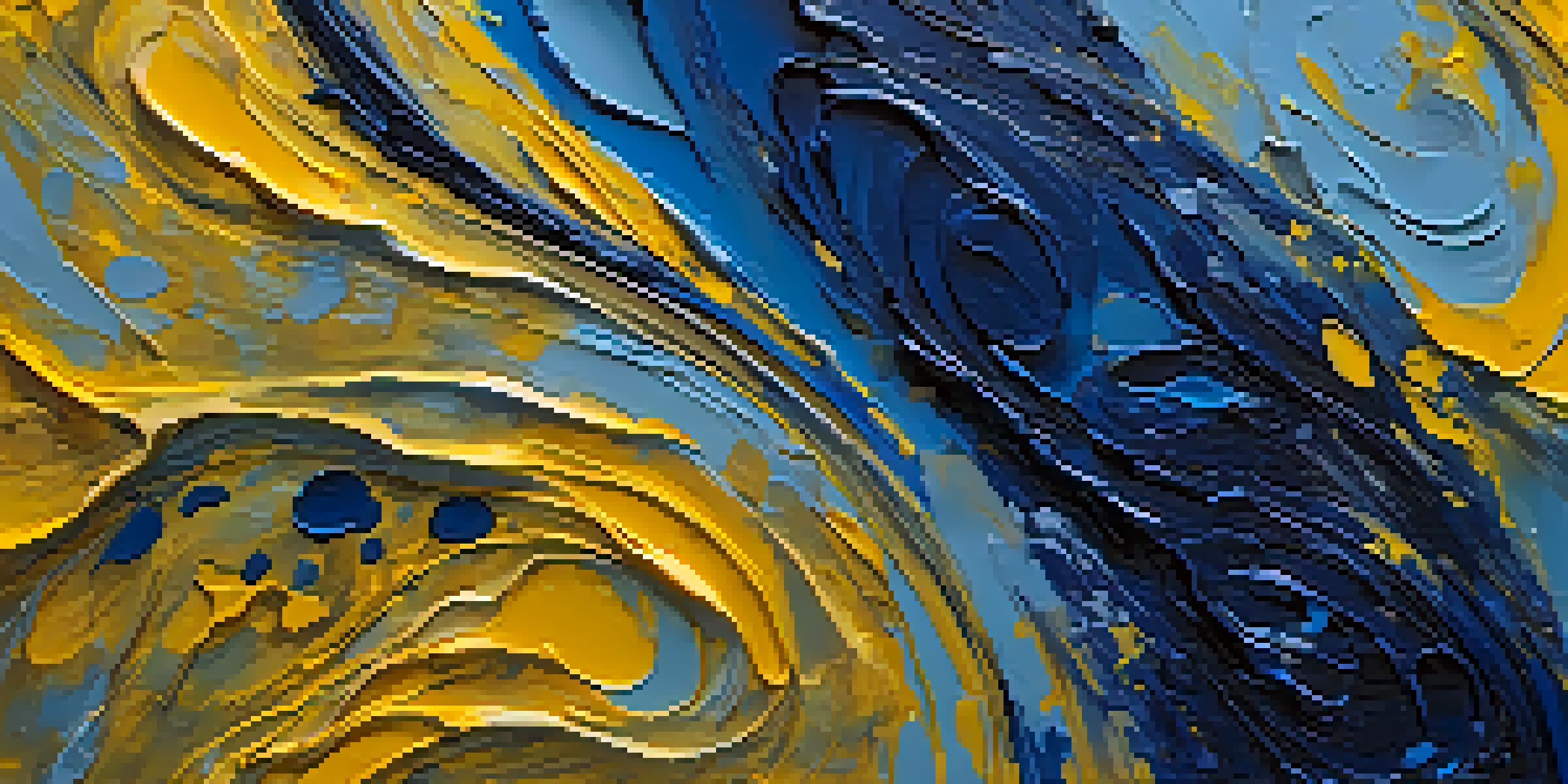Exploring the Use of Textures in Acrylic and Oil Paintings

Understanding Texture in Painting: What Is It?
Texture in painting refers to the surface quality or feel of a piece of art. It can be visual, where the painting appears to have texture without physically altering the surface, or actual, where the surface itself is raised or has varying levels. This concept not only adds depth to a piece but also engages the viewer's sense of touch and sight.
Texture is the feel of a surface, a tangible sensation that can evoke a tangible response in the viewer.
In both acrylic and oil mediums, texture can be created through techniques like layering, impasto, or even using different tools. For instance, using a palette knife can create sharp ridges and valleys in oil paint, while acrylics can be manipulated with brushes, sponges, or even fingers for varied effects. This versatility is one reason why artists love to explore textures.
When artists incorporate texture, they can evoke emotions and highlight focal points in their works. Imagine a serene landscape where the soft texture of clouds contrasts with the rough terrain below; this not only draws the viewer's eye but also creates a more immersive experience.
The Role of Texture in Acrylic Paintings
Acrylic paints are known for their quick drying time and versatility, making them ideal for texture experimentation. Artists can layer colors while they are still wet or use mediums that extend drying time, allowing for blending and textural development. This adaptability allows for a range of textures, from smooth washes to thick, sculptural applications.

One popular technique in acrylic painting is the use of gels and pastes to create texture. These additives can be mixed with paint or applied on their own to build volume and dimension on the canvas. For example, using heavy gel medium can result in a surface that mimics the look of stone or other natural materials.
Texture Enhances Artistic Depth
Texture adds visual complexity and emotional depth to paintings, engaging viewers more intensely.
Additionally, acrylic paint can be manipulated with tools such as brushes, combs, or even everyday objects like credit cards. Each method provides a unique texture, allowing artists to express their creativity and style in distinct ways. This freedom can lead to truly innovative artwork that captivates the viewer.
Exploring Texture Techniques in Oil Paintings
Oil paints offer a rich, buttery consistency that lends itself beautifully to textural techniques. Unlike acrylics, oil paint dries slowly, allowing artists to work and rework textures over an extended period. This slow drying time can be advantageous when layering or blending colors to create intricate textures.
Art is not what you see, but what you make others see.
Impasto is a popular oil painting technique that involves applying paint thickly to the canvas, creating a three-dimensional effect. This method can add dramatic highlights and shadows, giving life to elements such as flowers or landscapes. The raised texture invites viewers to experience the artwork in a more tactile way.
Moreover, oil painters can experiment with various tools to create textures that mimic different materials. For instance, using a bristle brush can create a rough texture, while a soft brush can yield smoother applications. This versatility encourages artists to push their boundaries and explore new creative avenues.
Combining Acrylic and Oil Textures: A Mixed Media Approach
The world of mixed media art allows for even more experimentation with texture by combining acrylics and oils. Artists can start with acrylics to create a base layer of texture, then finish with oil paints to add depth and richness. This combination not only enhances the visual appeal but also introduces unique textural contrasts.
For example, an artist might use a thick acrylic paste to build up a landscape's terrain and then glaze over it with oil paint to create atmospheric effects. This layering can result in a captivating interplay of light and shadow, giving the artwork a sense of movement and life.
Acrylics and Oils: Unique Textures
Both acrylic and oil paints offer diverse techniques for creating textures, allowing artists to express their creativity.
When mixing these mediums, it's essential to remember that acrylics dry faster than oils. Artists must plan their layering carefully to ensure proper adhesion and avoid issues with drying times. However, when executed thoughtfully, the results can be breathtaking and truly innovative.
Using Texture to Convey Emotion in Art
Texture plays a crucial role in conveying emotions within a painting. Different textures can evoke various feelings; for example, smooth surfaces often feel calm and serene, while rough textures can evoke tension or chaos. By thoughtfully choosing textures, artists can enhance the emotional impact of their work.
Consider a painting of a stormy sea: using thick, jagged strokes can create a sense of turbulence, while smoother areas might depict the calm before the storm. This contrast not only captures the viewer's attention but also allows them to feel the narrative behind the artwork.
Ultimately, the use of texture becomes a visual language, allowing artists to express complex emotions and ideas. It invites viewers to connect with the artwork on a deeper level, sparking reflection and conversation.
Tips for Experimenting with Texture in Your Artwork
If you’re eager to explore texture in your own painting practice, start by gathering various tools and materials. Experiment with brushes, palette knives, sponges, or even natural objects like leaves or fabric to see how they interact with your chosen medium. Each tool can produce a different texture, adding diversity to your artwork.
Don’t be afraid to layer and build up textures. Begin with a base layer, then add thicker applications or use mediums to create volume. The key is to have fun and enjoy the process—sometimes the best textures come from happy accidents or spontaneous ideas.
Experimenting with Mixed Media
Combining acrylics and oils in mixed media opens up new possibilities for texture and visual contrast in artwork.
Finally, take the time to observe how texture works in the artworks of others. Whether it’s visiting galleries or exploring online, analyzing how different artists use texture can inspire your own creativity. Remember, texture is not just about the surface; it’s about the story your artwork tells.
Conclusion: The Significance of Texture in Painting
In conclusion, texture is a powerful tool in the realm of acrylic and oil painting. It enhances the visual experience, conveys emotion, and invites viewers to engage more deeply with the artwork. Artists who embrace texture can create more dynamic and impactful pieces that resonate with their audience.
Whether through the smoothness of a glaze or the boldness of impasto, texture adds a layer of complexity that enriches the artistic narrative. As you experiment with different techniques and tools, consider how texture can elevate your own work.

Ultimately, the exploration of texture in painting is an invitation to push creative boundaries and discover new artistic possibilities. So grab your brushes, and let your imagination run wild as you dive into the world of texture!